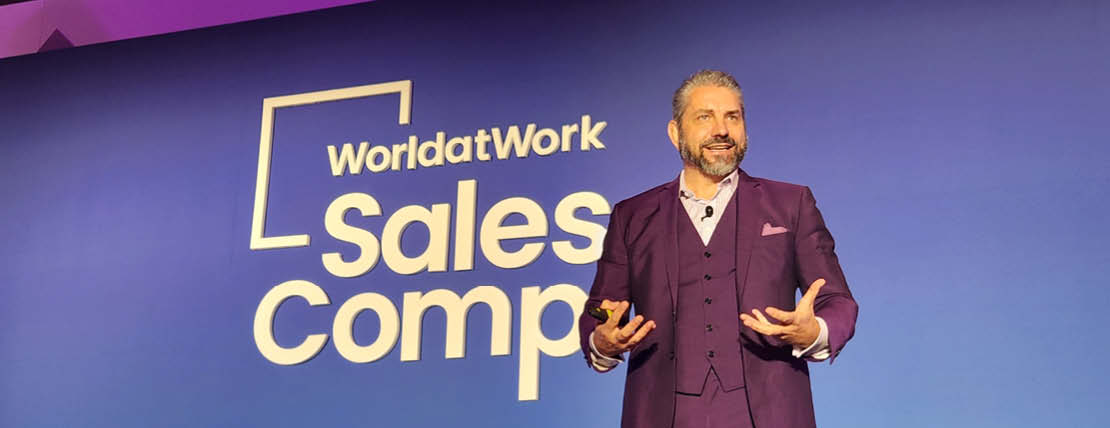For WorldatWork Members
- How to Navigate Tariff Uncertainty with a Responsive Sales Comp Strategy, Workspan Magazine article
- Managing Change — Sales Compensation Takes the Lead, Workspan Magazine article
- Sales Performance Management, research
- Sales Compensation Programs and Practices, research
For Everyone
- 6 Keys to Help You Design Sales Comp Plans Like a Pro, Workspan Daily article
- Comp Strategies for New Sales Hires: Balancing Motivation and Finances, Workspan Daily article
- Certified Sales Compensation Professional, certification
- Sales Compensation: Foundation and Core Principles, course
- Sales Compensation Course Series, course
Andrew Sykes understands bad habits. He smoked his first cigarette at the age of 6 after his older brother offered him one. That was the start of a 30-year smoking journey. It didn’t matter that he worked in the healthcare industry, selling smoking-cessation programs to organizations; it was a habit he couldn’t break. A self-described “social smoker,” it wasn’t until the death of his mother and a promise he made to her to quit smoking that he decided it was time to change.
Sykes (pictured above), now a professor at Northwestern University’s Kellogg School of Management and the CEO and founder of sales training company Habits at Work, spoke about modifying rote tendencies during his Monday morning main-stage session, “Changing Habits: The Ultimate Goal of Sales Compensation Plans,” at WorldatWork’s Sales Comp ’25 conference in Chicago.
Using research from the Behavioral Research Applied Technology Laboratory (BRATLAB) on how humans think, feel and act, and how to create new habits, Sykes said he learned that “who we are and what we produce in the world is nothing more than the sum of our habits.”
“We are made up of our habits,” he told the audience of sales compensation professionals, explaining to them these behaviors can be applied to create better context designs for their part of the total rewards puzzle.
Access an additional article from WorldatWork’s Sales Comp ’25 conference:
- Pursuing a Career in Sales Compensation? Here Are 5 Suggestions
- How HPE Transformed Its Sales Comp Strategies to Grow and Innovate
Factoring 4 Contexts into Sales Design
According to Sykes, the four contexts that influence people in their daily work and lives include:
- Physical spaces. The physical environment in which employees conduct their work, which includes the home working environment or a field office, as well as the more traditional head office and factory floor.
- Workplace systems. The policies, procedures, business processes or rules (written and unwritten) that employees are expected to follow.
- Social influence. The people we work with every day who influence what we do and how we do it. The day-to-day interactions with work colleagues and customers via live conversations, emails and shared experiences (including events) all strongly influence how we work and what we achieve.
- Our mindset. Humans interpret the world through individual experiences, opinions, beliefs, knowledge and other filters. The stories we tell ourselves about the experiences we’ve had in the past hold the power to influence us in the present, which is why storytelling is such an effective influence method for employers.
“Our job is to design these four contexts around our sales teams,” Sykes said.
But changing habits is hard work (for example, Sykes said it took him two years of on-and-off-again smoking to finally kick the habit). Why people fail at changing habits or their behaviors, he said, can be attributed to three reasons:
- Humans can only successfully change one habit at a time.
- Before you can create a habit, you have to delete a habit of the same “size and time.”
- You don’t have habits; your habits have you — meaning humans are conditioned to behave in certain ways in certain environments (for example, how a person acts walking into a library is likely different than how they act walking into a bar).
Excellence ... Not a Singular Act
To help sales teams create new habits, Sykes said leaders need to understand two forces: motivation (which Sykes defined as “the urge or compulsion to do something, and is a stronger feeling than desire”) and capability (defined as “competence and confidence combined”).
Sykes also cautioned there are two additional forces that act against motivation and capability. They are barriers (“static impediments to change”) and temptations (“active antagonists that draw us away from the actions to which we’re committed”).
Motivating a sales team is generally never a problem, he said — it’s usually because a barrier gets in the way. (Sykes noted offering more compensation as a motivator is the more expensive way to change behavior and is only a temporary fix.) Instead, what leaders should do is create formulas for habit creations. They are the power to:
- Inspire motivation;
- Grow capability;
- Overcome barriers; and,
- Resist temptations.
By adding these powers — in addition to strong compensation skills and experience — to your toolbox of context design, Sykes said it can create a high-performance culture. Ultimately, understanding the four contexts and applying the formulas for new habit creation can generate success for your sales teams.
“Excellence is not a singular act but a set of habits over time,” he said.
Editor’s Note: Additional Content
For more information and resources related to this article, see the pages below, which offer quick access to all WorldatWork content on these topics:
#1 Total Rewards & Comp Newsletter
Subscribe to Workspan Weekly and always get the latest news on compensation and Total Rewards delivered directly to you. Never miss another update on the newest regulations, court decisions, state laws and trends in the field.








